DS证据理论分析
证据理论方法详解分析
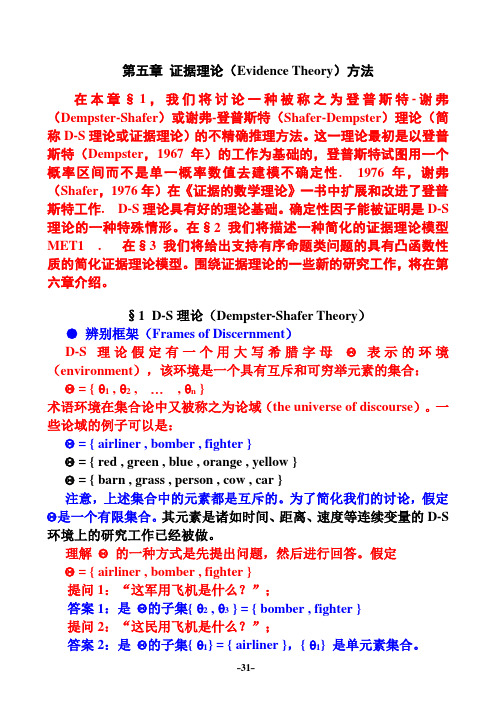
第五章证据理论(Evidence Theory)方法在本章§1,我们将讨论一种被称之为登普斯特-谢弗(Dempster-Shafer)或谢弗-登普斯特(Shafer-Dempster)理论(简称D-S理论或证据理论)的不精确推理方法。
这一理论最初是以登普斯特(Dempster,1967年)的工作为基础的,登普斯特试图用一个概率区间而不是单一概率数值去建模不确定性. 1976年,谢弗(Shafer,1976年)在《证据的数学理论》一书中扩展和改进了登普斯特工作. D-S理论具有好的理论基础。
确定性因子能被证明是D-S 理论的一种特殊情形。
在§2我们将描述一种简化的证据理论模型MET1 . 在§3我们将给出支持有序命题类问题的具有凸函数性质的简化证据理论模型。
围绕证据理论的一些新的研究工作,将在第六章介绍。
§1D-S理论(Dempster-Shafer Theory)●辨别框架(Frames of Discernment)D-S理论假定有一个用大写希腊字母Θ表示的环境(environment),该环境是一个具有互斥和可穷举元素的集合:Θ = { θ1 , θ2 , ⋯, θn }术语环境在集合论中又被称之为论域(the universe of discourse)。
一些论域的例子可以是:Θ = { airliner , bomber , fighter }Θ = { red , green , blue , orange , yellow }Θ = { barn , grass , person , cow , car }注意,上述集合中的元素都是互斥的。
为了简化我们的讨论,假定Θ是一个有限集合。
其元素是诸如时间、距离、速度等连续变量的D-S 环境上的研究工作已经被做。
理解Θ的一种方式是先提出问题,然后进行回答。
假定Θ = { airliner , bomber , fighter }提问1:“这军用飞机是什么?”;答案1:是Θ的子集{ θ2 , θ3 } = { bomber , fighter }提问2:“这民用飞机是什么?”;答案2:是Θ的子集{ θ1} = { airliner },{ θ1} 是单元素集合。
D-S证据理论方法
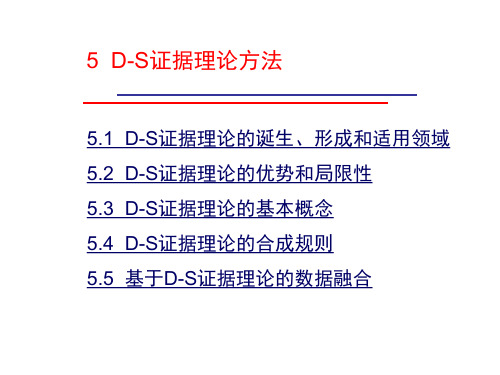
16
表5-1 命题的向量表示
序号 1 2 机型 我轰炸机 我大型机 向量表示 1000000000 0100000000 序号 11 12 含义 我小型机 敌小型机 向量表示 0011000000 0000001010
3
4 5
我小型机1
我小型机2 敌轰炸机1
0010000000
0001000000 0000100000
13
14 15
敌轰炸机
轰炸机 大型机
0000100100
1000100100 0100010000
6
7 8
敌大型机
敌小型机1 敌轰炸机2
0000010000
0000001000 0000000100
16
17 18
小型机
敌 我
0011001010
0000111110 1111000000
9
10
敌小型机2
M ( Ak ) c 1
其中
c 1
Am Ak 1 j J
M
( Ak )
j
( Am ),
m 1,, K
Ak 1 j J
M
j
Ak 1 j J
M
j
( Ak )
12
多传感器多测量周期可信度分配的融合
设 M s j ( Ak ) 表示第 s( s 1,...,S ) 个传感器在第 j ( j 1,...,n) 个测 量周期对命题 Ak (k 1,, K ) 的可信度分配 ,那么 Ak 的融合
后验可信度分配如何计算呢?
传感器1 传感器2
M1 j ( Ak )
不同周期融合 不同周期融合
D-S证据理论方法
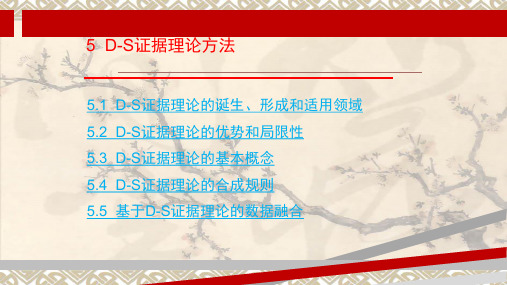
M(民航)=0.00228/0.229=0.01
M(不明)=0.000403/0.229=0.00176
21
分布式计算方法
传感器1
M 1 j ( Ak )
同
周
传感器2
M 2 j ( Ak )
期
融
传感器S
M S j ( Ak )
合
M1 ( Ak )
融 M 2 ( Ak ) 合 M ( Ak )
中 心
传感器1
传感器2
传感器n
命题的证据区间 命题的证据区间 命题的证据区间
证
据
组
合
最终判决规则
规
则
基于D-S证据方法的信息融合框图
融合 结果
11
单传感器多测量周期可信度分配的融合
设 M j ( A表k )示传感器在第
j( 个j 测1量,.周..,期J )对命题
Ak
(k 1, ,的K可) 信度分配值,则该传感器依据 个周期的测量积n累对命题 的
( A) PI(A) Bel( A)
对偶(Bel(A) ,Pl(A))称为信任空间。
7
证据区间和不确定性
信任区间
0
Bel(A)
支持证据区间
Pl(A)
拒绝证据区间
拟信区间
信任度是对假设信任程度的下限估计—悲观估计; 似然度是对假设信任程度的上限估计—乐观估计。
8
5.4 D-S证据理论的合成规则
5 D-S证据理论方法
5.1 D-S证据理论的诞生、形成和适用领域 5.2 D-S证据理论的优势和局限性 5.3 D-S证据理论的基本概念 5.4 D-S证据理论的合成规则 5.5 基于D-S证据理论的数据融合
《基于DS证据理论的多传感器数据融合算法研究与应用》
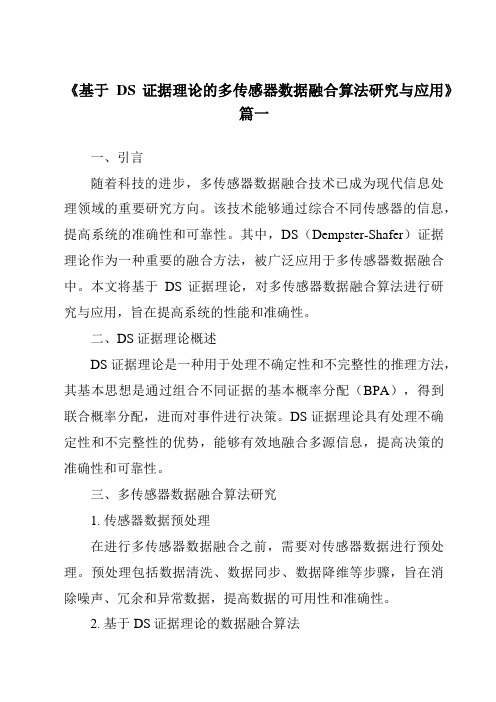
《基于DS证据理论的多传感器数据融合算法研究与应用》篇一一、引言随着科技的进步,多传感器数据融合技术已成为现代信息处理领域的重要研究方向。
该技术能够通过综合不同传感器的信息,提高系统的准确性和可靠性。
其中,DS(Dempster-Shafer)证据理论作为一种重要的融合方法,被广泛应用于多传感器数据融合中。
本文将基于DS证据理论,对多传感器数据融合算法进行研究与应用,旨在提高系统的性能和准确性。
二、DS证据理论概述DS证据理论是一种用于处理不确定性和不完整性的推理方法,其基本思想是通过组合不同证据的基本概率分配(BPA),得到联合概率分配,进而对事件进行决策。
DS证据理论具有处理不确定性和不完整性的优势,能够有效地融合多源信息,提高决策的准确性和可靠性。
三、多传感器数据融合算法研究1. 传感器数据预处理在进行多传感器数据融合之前,需要对传感器数据进行预处理。
预处理包括数据清洗、数据同步、数据降维等步骤,旨在消除噪声、冗余和异常数据,提高数据的可用性和准确性。
2. 基于DS证据理论的数据融合算法该算法首先对不同传感器的数据进行基本概率分配;然后,利用DS组合规则对不同传感器的BPA进行组合,得到联合概率分配;最后,根据联合概率分配进行决策。
四、算法应用本文将所提算法应用于智能交通系统和智能家居两个领域。
在智能交通系统中,通过融合来自雷达、摄像头、激光等不同传感器的数据,提高车辆感知和决策的准确性;在智能家居中,通过融合温度、湿度、光照等传感器的数据,实现智能控制和节能。
五、实验与分析1. 实验设置为了验证所提算法的有效性,本文设计了多个实验场景。
在智能交通系统中,使用真实交通场景的数据进行实验;在智能家居中,使用模拟数据进行实验。
实验中,分别对所提算法与其他算法进行对比,评估其性能和准确性。
2. 实验结果与分析实验结果表明,所提算法在智能交通和智能家居领域均取得了较好的效果。
在智能交通系统中,所提算法提高了车辆感知和决策的准确性,降低了误报和漏报率;在智能家居中,所提算法实现了智能控制和节能,提高了居住的舒适度和节能效果。
基于DS证据理论的不确定信息决策方法

多源情报融合:在军事、安全等领域,将来自不 同情报机构或来源的情报信息进行融合,以获得 对敌方意图、行动等的全面评估。
这些方法的应用都表明了基于DS证据理论的信息 融合方法在处理不确定信息决策中的有效性和实 用性。
局限性
基于模糊数学的决策方法:虽然可以处理模糊信息,但 往往对信息的模糊性有较强的假设,适用范围有限。
基于DS证据理论的不确定信息决策方法的优势
处理不完全信息:DS证据理论能 够融合多种来源的信息,减少信 息不确定性对决策的影响。
灵活性:DS证据理论对于信息的 模糊性和不确定性具有较强的适 应性,可以根据实际情况调整证 据的信任度和似真度。
决策规则
基于组合后的信任函数,DS证据理论采用一定的决策规则来 做出决策,常见的决策规则包括最大信任度规则、最小风险 规则等。
DS证据理论的应用范围
多传感器数据融合
DS证据理论可以应用于多传感器 数据融合中,将不同传感器提供 的冗余或互补信息进行融合,提
高整体系统的性能和鲁棒性。
智能决策支持系统
DS证据理论可用于构建智能决策 支持系统,通过综合考虑各种不 确定因素,辅助决策者做出更加
结合深度学习
鉴于深度学习在特征提取和模式识别方面的强大能力,未来的研究可以探索如何将DS证据理论与深度学习相结合,以处理更复杂的不确定信息决策问题。
实际应用价值与推广建议
实际应用价值
基于DS证据理论的不确定信息决策方法具 有广泛的应用前景,可以应用于风险管理、 投资决策、医疗诊断、环境评估等多个领域 。它可以帮助决策者更好地处理不确定性, 提高决策的准确性和效率。
《DS证据理论》课件

DS证据理论的基本原 则和概念
DS证据理论的基本原则包括 证据的量化、证据的集成和 证据的推理。
DS证据理论的核心内容
证据价值评估模型
通过评估不同证据的价值,帮助决策者做出准确的 判断。
Байду номын сангаас
证据可信度量化模型
将证据的可信度量化为具体的数值,用于衡量证据 的可靠程度。
DS证据理论的应用
法律领域的应用
证据收集与保全、证据调取与审查、证据鉴定与证 明等方面。
知识管理领域的应用
知识组织与管理、知识发现与推理、知识创新与应 用等方面。
结语
DS证据理论的现状和前景
DS证据理论在实践中取得了显著成果,应用前景广阔。
DS证据理论的研究方向和挑战
未来的研究方向包括证据的自动化处理和证据的大数据分析。
DS证据理论的启示和建议
DS证据理论提醒我们在决策过程中要重视证据的价值和可信度。
《DS证据理论》PPT课件
DS证据理论是一种理论框架,用于评估和量化证据的价值和可信度,在法律 和知识管理领域有广泛应用。本课件将介绍DS证据理论的基本原理和应用。
DS证据理论简介
什么是DS证据理论?
DS证据理论是一种用于评估 和量化证据的价值和可信度 的方法论。
DS证据理论的起源和 发展
DS证据理论最早由格伦·肯 伊·罗贝特在20世纪70年代提 出,并不断得到发展和完善。
D—S证据理论在目标特征数据分析中的应用
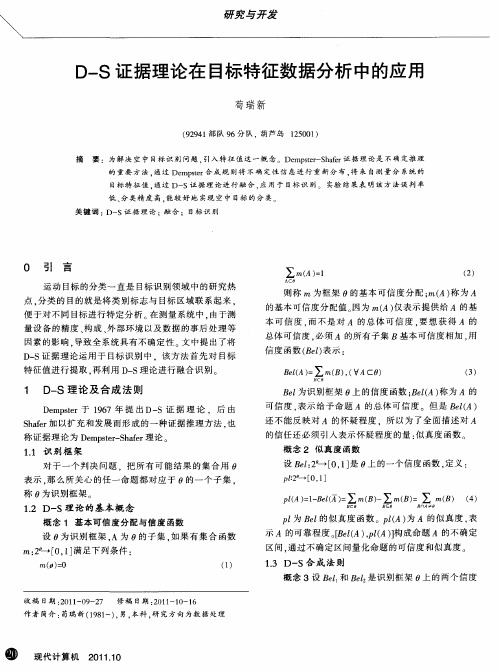
关 键 词 :D—S证 据 理 论 :融 合 :目标 识 别
0 引 言
运动 目标 的分类一直是 目标识 别领域 中的研究热
点. 分类 的 目的 就 是 将 类 别 标 志 与 目标 区 域 联 系 起 来 . 便 于对 不 同 目标 进 行 特 定 分 析 在 测量 系统 中 . 由于 测
表示 . 么所关心的任一命题都对应 于 0的一个 子集 . 那
称 0为识 别 框架
12 . D— S理 论 的基 本 概 念
概 念 1 基本 可信 度 分 配 与信 度 函数
pA= B ()∑m 一 eB=∑ m曰 ( l ) 一eA= ()∑r ) ( 1 l ( () 4 )
C 口 B n A ≠
m( = ) 0 ( ) 1
区间 . 通过不确定 区间量化命题的可信度和似真度 。
13 . D- S合 成 法 则
概 念 3设 Z和 f是 识 别 框 架 上 的 两 个 信 度 . 1
收 稿 日期 :0 1 0 —2 21— 9 7
修 稿 日期 :0 1 O 6 2 1 —1 一1
的 重要 方 法 , 过 De s r 成 规 则将 不确 定性 信 息 进 行 重 新 分 布 , 来 自测 量 分 系统 的 通 mpt 合 e 将
目标 特 征 值 . 过 D— 通 S证 据 理 论 进 行 融 合 , 用 于 目标 识 别 。 实验 结 果表 明 该 方 法 误 判 率 应
Be l l Be , l
m ( ・ ( < )m2 A 马) 1
A nB≠ p
Be n 1 Be ( 1 1 +) n
D-S证据理论(Dempster-Shaferenvidencetheory)
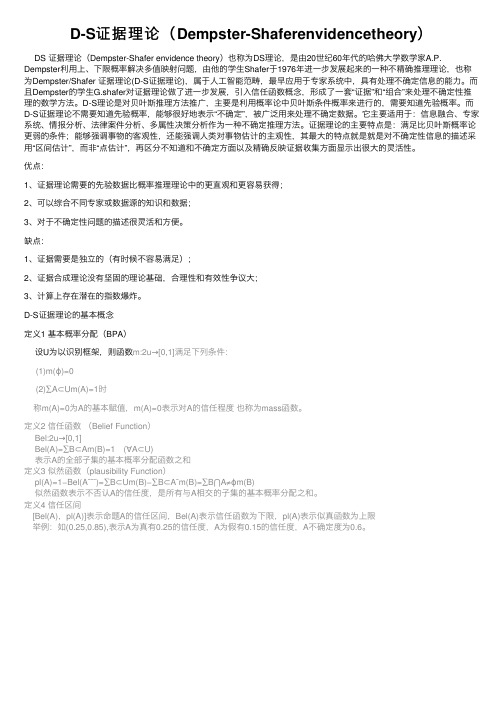
D-S证据理论(Dempster-Shaferenvidencetheory)DS 证据理论(Dempster-Shafer envidence theory)也称为DS理论,是由20世纪60年代的哈佛⼤学数学家A.P. Dempster利⽤上、下限概率解决多值映射问题,由他的学⽣Shafer于1976年进⼀步发展起来的⼀种不精确推理理论,也称为Dempster/Shafer 证据理论(D-S证据理论),属于⼈⼯智能范畴,最早应⽤于专家系统中,具有处理不确定信息的能⼒。
⽽且Dempster的学⽣G.shafer对证据理论做了进⼀步发展,引⼊信任函数概念,形成了⼀套“证据”和“组合”来处理不确定性推理的数学⽅法。
D-S理论是对贝叶斯推理⽅法推⼴,主要是利⽤概率论中贝叶斯条件概率来进⾏的,需要知道先验概率。
⽽D-S证据理论不需要知道先验概率,能够很好地表⽰“不确定”,被⼴泛⽤来处理不确定数据。
它主要适⽤于:信息融合、专家系统、情报分析、法律案件分析、多属性决策分析作为⼀种不确定推理⽅法。
证据理论的主要特点是:满⾜⽐贝叶斯概率论更弱的条件;能够强调事物的客观性,还能强调⼈类对事物估计的主观性,其最⼤的特点就是就是对不确定性信息的描述采⽤“区间估计”,⽽⾮“点估计”,再区分不知道和不确定⽅⾯以及精确反映证据收集⽅⾯显⽰出很⼤的灵活性。
优点:1、证据理论需要的先验数据⽐概率推理理论中的更直观和更容易获得;2、可以综合不同专家或数据源的知识和数据;3、对于不确定性问题的描述很灵活和⽅便。
缺点:1、证据需要是独⽴的(有时候不容易满⾜);2、证据合成理论没有坚固的理论基础,合理性和有效性争议⼤;3、计算上存在潜在的指数爆炸。
D-S证据理论的基本概念定义1 基本概率分配(BPA) 设U为以识别框架,则函数m:2u→[0,1]满⾜下列条件:(1)m(ϕ)=0(2)∑A⊂Um(A)=1时称m(A)=0为A的基本赋值,m(A)=0表⽰对A的信任程度也称为mass函数。
《基于DS证据理论的多传感器数据融合算法研究与应用》

《基于DS证据理论的多传感器数据融合算法研究与应用》篇一一、引言在当代科技快速发展的背景下,多传感器数据融合技术已成为众多领域中不可或缺的组成部分。
多传感器数据融合技术通过整合来自不同传感器的信息,能够提高数据的准确性和可靠性,为决策提供有力支持。
本文将重点研究基于DS(Dempster-Shafer)证据理论的多传感器数据融合算法,并探讨其在实际应用中的价值。
二、DS证据理论概述DS证据理论是一种用于处理不确定性和不完全性信息的理论框架,它通过组合不同证据的信念来得出新的信念。
在DS证据理论中,一个框架代表了所有可能的事件或假设的集合。
每个证据或信念都会对应一个基本概率分配(BPA),反映了事件或假设的可能性。
通过DS组合规则,可以综合不同证据的基本概率分配,得到新的基本概率分配,从而实现对不确定性的推理。
三、多传感器数据融合算法研究基于DS证据理论的多传感器数据融合算法主要包括以下几个步骤:1. 数据预处理:对来自不同传感器的原始数据进行清洗、去噪和标准化处理,以消除数据间的冗余和矛盾。
2. 特征提取:从预处理后的数据中提取出有用的特征信息,为后续的融合处理提供基础。
3. 建立证据框架:根据实际需求,确定多传感器数据融合的证据框架,包括所有可能的事件或假设。
4. 基本概率分配:为每个证据在证据框架下的基本概率分配进行计算,反映各事件或假设的可能性。
5. 融合处理:利用DS组合规则,将不同证据的基本概率分配进行综合,得到新的基本概率分配。
6. 决策输出:根据融合后的基本概率分配,进行决策或推断。
四、算法应用基于DS证据理论的多传感器数据融合算法在多个领域中得到了广泛应用,如智能监控、无人驾驶、目标识别等。
以智能监控为例,通过安装在不同位置的多个摄像头和其他传感器,可以获取目标的多维度信息。
利用DS证据理论的多传感器数据融合算法,可以综合这些信息,提高目标识别的准确性和可靠性。
此外,在无人驾驶领域,该算法也可以用于融合来自雷达、激光雷达、摄像头等传感器的信息,提高车辆的感知能力和决策准确性。
DS证据理论课件

REPORTING
2023 WORK SUMMARY
DS证据理论课件
汇报人:XX
XX
目录
• DS证据理论概述 • DS证据组合规则 • 信任函数与似然函数 • DS证据理论在决策中的应用 • DS证据理论在模式识别中的应用 • DS证据理论在故障诊断中的应用 • 总结与展望
PART 01
DS证据理论概述
• 归一化处理:m'(A) = m(A) / (m(A) + m(B) + m(A∪B)) = 0.42 / (0.42 + 0.12 + 0.46) = 0.4375,m'(B) = m(B) / (m(A) + m(B) + m(A∪B)) = 0.12 / (0.42 + 0.12 + 0.46) = 0.125,m'(A∪B) = m(A∪B) / (m(A) + m(B) + m(A∪B)) = 0.46 / (0.42 + 0.12 + 0.46) = 0.475
PART 05
DS证据理论在模式识别 中的应用
模式识别问题描述与建模
01
02
03
模式识别问题定义
阐述模式识别的基本概念 、分类和应用领域。
特征提取与选择
介绍如何从原始数据中提 取有效特征,以及特征选 择的方法。
模式识别建模
详细解释模式识别的建模 过程,包括模型假设、参 数估计和模型验证等。
基于DS证据理论的模式识别方法
• 举例:假设有两个独立的证据E1和E2,分别对应两个命题A和B。E1对A和B 的支持度分别为0.6和0.4,E2对A和B的支持度分别为0.7和0.3。根据DS证据 组合规则,可以先计算两个证据对A和B的联合支持度,再归一化得到组合后 的BPA。具体计算过程如下
《DS证据理论》

❖ A(0,0.85):由于Bel(A)=0,而Bel(¬A)=1一Pl(A)=1-0.85= 0.15,所以A(0,0.85)表示对A为假有一定程度的信任,信任度为0.15。
❖ A(0.25,0.85):由于Bel(A)=0.25,说明对A为真有0.25的信任度;由于 Bel(¬A)=1-0.85=0.15,说明对A为假有0.15的信任度。所以A(0.25, 0.85)表示对A为真的信任度比对A为假的信任度稍高一些。
定义:若A⊆D则M(A)≠0,称A为M的一个焦元。
3. 概率分配函数不是概率。
2. 信任函数
定义2 :命题的信任函数Bel:2D→[0,1],且 Bel(A)=ΣM(B)对所有的A⊆D
B⊆A
其中2D表示D的所有子集。 Bel函数又称为下限函数,Bel(A)表示对命题A
为真的信任程度。 由信任函数及概率分配函数的定义推出: Bel(Φ)=M(Φ)=0 Bel(D)=ΣM(B)=1
B⊆D
3. 似然函数
定义3: 似然函数Pl:2D→[0,1],且 Pl(A)=1一Bel(¬A) 其中A⊆D 似然函数的含义:由于Bel(A)表示对A为
真的信任程度,所以Bel(¬A)就表示对非A为 真,即A为假的信任程度,由此可推出Pl(A )表示对A为非假的信任程度。 似然函数又称为不可驳斥函数或上限函数。
0≤CER(E)≤1
4. 组合证据不确定性的算法
❖ 当组合证据是多个证据的合取时,即
E=E1 AND E2 AND … AND En
❖ 则E的确定性CER(E)为:
CER(E)=min{CER(El),CER(E2), …,CER(En)}
❖ 当组合证据是多个证据的析取时,即
E=El OR E2 OR … OR En
DS证据理论改进方法综述 - 副本
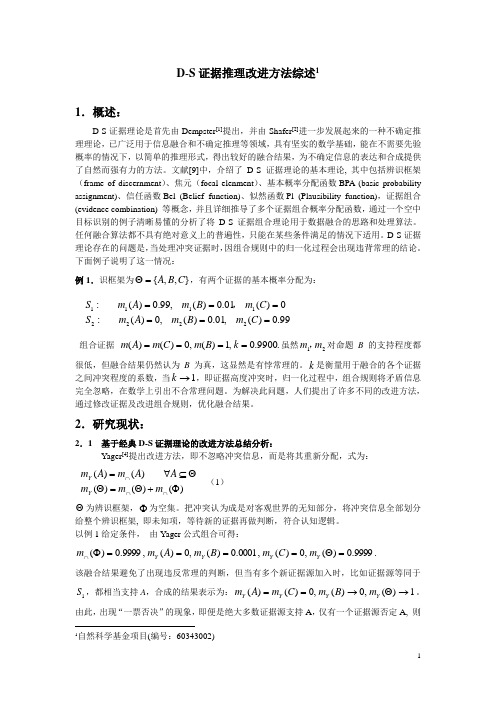
D -S 证据推理改进方法综述11.概述:D-S 证据理论是首先由Dempster [1]提出,并由Shafer [2]进一步发展起来的一种不确定推理理论,已广泛用于信息融合和不确定推理等领域,具有坚实的数学基础,能在不需要先验概率的情况下,以简单的推理形式,得出较好的融合结果,为不确定信息的表达和合成提供了自然而强有力的方法。
文献[9]中,介绍了D-S 证据理论的基本理论, 其中包括辨识框架(frame of discernment )、焦元(focal elenment )、基本概率分配函数BPA (basic probability assignment)、信任函数Bel (Belief function)、似然函数Pl (Plausibility function),证据组合(evidence combination) 等概念,并且详细推导了多个证据组合概率分配函数,通过一个空中目标识别的例子清晰易懂的分析了将D-S 证据组合理论用于数据融合的思路和处理算法。
任何融合算法都不具有绝对意义上的普遍性,只能在某些条件满足的情况下适用。
D-S 证据理论存在的问题是,当处理冲突证据时,因组合规则中的归一化过程会出现违背常理的结论。
下面例子说明了这一情况:例1.识框架为},,{C B A =Θ,有两个证据的基本概率分配为:99.0)(,01.0)(,0)(:0)(01.0)(,99.0)(:22221111======C m B m A m S C m B m A m S ,组合证据 .9900.0,1)(,0)()(====k B m C m A m 虽然21m m ,对命题B 的支持程度都很低,但融合结果仍然认为B 为真,这显然是有悖常理的。
k 是衡量用于融合的各个证据之间冲突程度的系数,当1→k ,即证据高度冲突时,归一化过程中,组合规则将矛盾信息完全忽略,在数学上引出不合常理问题。
为解决此问题,人们提出了许多不同的改进方法,通过修改证据及改进组合规则,优化融合结果。
《基于DS证据理论的多传感器数据融合算法研究与应用》
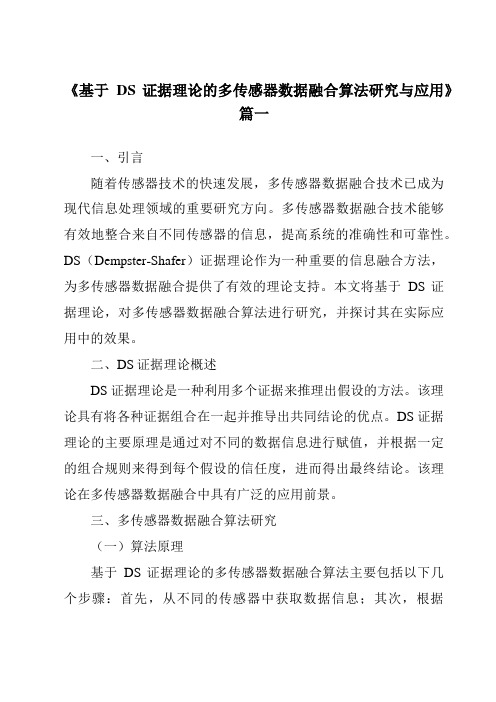
《基于DS证据理论的多传感器数据融合算法研究与应用》篇一一、引言随着传感器技术的快速发展,多传感器数据融合技术已成为现代信息处理领域的重要研究方向。
多传感器数据融合技术能够有效地整合来自不同传感器的信息,提高系统的准确性和可靠性。
DS(Dempster-Shafer)证据理论作为一种重要的信息融合方法,为多传感器数据融合提供了有效的理论支持。
本文将基于DS证据理论,对多传感器数据融合算法进行研究,并探讨其在实际应用中的效果。
二、DS证据理论概述DS证据理论是一种利用多个证据来推理出假设的方法。
该理论具有将各种证据组合在一起并推导出共同结论的优点。
DS证据理论的主要原理是通过对不同的数据信息进行赋值,并根据一定的组合规则来得到每个假设的信任度,进而得出最终结论。
该理论在多传感器数据融合中具有广泛的应用前景。
三、多传感器数据融合算法研究(一)算法原理基于DS证据理论的多传感器数据融合算法主要包括以下几个步骤:首先,从不同的传感器中获取数据信息;其次,根据DS证据理论对每个传感器数据进行赋值;然后,根据一定的组合规则计算每个假设的信任度;最后,得出结论。
(二)算法实现在实现过程中,需要选择合适的传感器,并确保传感器之间的数据传输和同步。
同时,还需要对数据进行预处理和噪声消除等操作。
此外,为了满足实时性要求,还需要对算法进行优化和加速处理。
(三)算法优势基于DS证据理论的多传感器数据融合算法具有以下优势:首先,能够有效地整合来自不同传感器的信息,提高系统的准确性和可靠性;其次,能够处理具有不确定性和模糊性的信息;最后,能够适应不同的环境和场景需求。
四、应用实例分析(一)应用场景基于DS证据理论的多传感器数据融合算法在许多领域都有广泛的应用,如智能交通、智能安防、无人驾驶等。
以智能交通为例,该算法可以用于车辆检测、交通流量统计、交通事件识别等方面。
(二)应用效果以某城市交通监控系统为例,采用基于DS证据理论的多传感器数据融合算法后,能够有效地提高交通监控的准确性和实时性。
DS证据理论分析

DS证据理论分析
证据权重表示一项证据对概率假设的支持程度,通常用一个介于0和1之间的数值表示。
当证据权重为1时,表示证据对概率假设的支持非常强,而当权重为0时,表示证据对概率假设没有任何支持。
信任函数则表示不同证据之间的组合方式,它是将证据权重映射到概率分配上的函数,通常采用的是Dempster-Shafer(DS)证据理论的规则。
DS证据理论的应用范围非常广泛,涵盖了多个领域。
例如,在法律领域,DS证据理论可以用于判断被告是否有罪,通过对不同证据的分析和组合,可以推断被告有罪的概率。
在医学诊断中,DS证据理论可以用于评估患者是否患有其中一种疾病,通过对患者的不同症状和检测结果的分析和组合,可以推断患者患病的可能性。
DS证据理论的分析过程可以分为三个主要步骤:观察证据、计算证据权重和组合证据。
观察证据是指从现实生活中收集和获取各种证据。
计算证据权重是指通过数学公式或计算方法,将证据的权重从原始数据转化为DS证据权重。
组合证据是指将不同证据的权重进行组合,得出最终的概率假设。
总结来说,DS证据理论是一种通过考虑证据权重和信任函数来推断概率假设真实度的方法。
该理论的应用广泛,可以用于法律、医学等多个领域。
在应用该理论进行分析时,需要考虑证据的可靠性和不确定性,以及对证据的观察、计算权重和组合证据三个主要步骤的操作。
ds证据理论
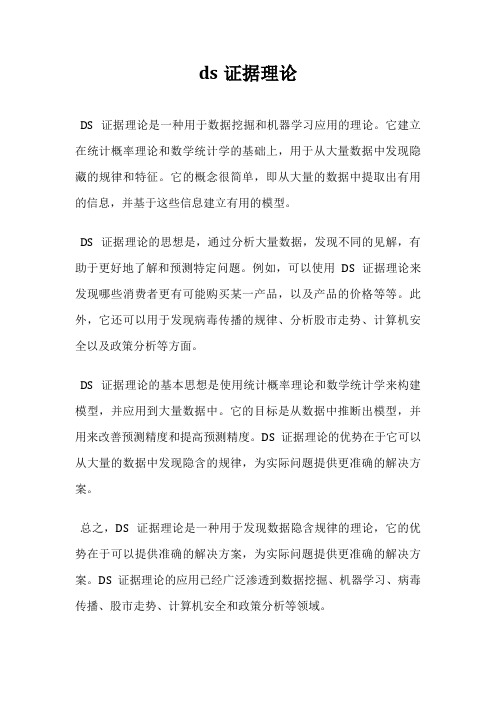
ds证据理论
DS证据理论是一种用于数据挖掘和机器学习应用的理论。
它建立在统计概率理论和数学统计学的基础上,用于从大量数据中发现隐藏的规律和特征。
它的概念很简单,即从大量的数据中提取出有用的信息,并基于这些信息建立有用的模型。
DS证据理论的思想是,通过分析大量数据,发现不同的见解,有助于更好地了解和预测特定问题。
例如,可以使用DS证据理论来发现哪些消费者更有可能购买某一产品,以及产品的价格等等。
此外,它还可以用于发现病毒传播的规律、分析股市走势、计算机安全以及政策分析等方面。
DS证据理论的基本思想是使用统计概率理论和数学统计学来构建模型,并应用到大量数据中。
它的目标是从数据中推断出模型,并用来改善预测精度和提高预测精度。
DS证据理论的优势在于它可以从大量的数据中发现隐含的规律,为实际问题提供更准确的解决方案。
总之,DS证据理论是一种用于发现数据隐含规律的理论,它的优势在于可以提供准确的解决方案,为实际问题提供更准确的解决方案。
DS证据理论的应用已经广泛渗透到数据挖掘、机器学习、病毒传播、股市走势、计算机安全和政策分析等领域。
DS证据理论中的证据组合

系统工程与电子技术SYSTEMS ENGINEERING ANDELECTRONICS1999 Vol.21 No.12 P.92-94D-S证据理论中的证据组合杜文吉 谢维信 摘 要 Dempster证据组合规则在D-S证据理论中将几组相互独立的证据融合,得到一组新的证据。
Dempster证据组合规则在D-S证据理论中起着十分重要的作用。
在对Dempster证据组合规则进行分析的基础上,提出了一组更加一般化的证据组合规则,即证据的逻辑运算及基于相似性加权的证据组合规则。
它们具有与Dempster证据组合规则不同的性质和应用背景。
主题词 置信界限 逻辑运算 信息交换 +证据组合 文章编号:1001-506X(1999)12-0092-03Evidence Combination Methods in D-S Evidence TheoryDu Wenji Xie Weixin(Xidian University, Electronic Engineering College,Xi'an 710071) Abstract Dempster's rule is used to combine probabilistically independent sets of evidence to improve the reliability or dependability of evidence information associated with different data sources. Dempster's rule plays a very important role in D-S evidence theory. Through analysis the property of the dempster's rule, we proposd some logic operation on sets of evidence, which is a much more generalized methods for combining probabilistically independent sets of evidence. A weighted dempster's rule of combination handling sets of evidence from various sources with different priority is also given, based on analysis of conjunctive combination defined by the min operation weighted by degree of consistency. Keywords Evidence theory Dempster combination rule Message suttching1 引 言 D-S证据理论[1]形成于60年代。
D-S证据理论方法
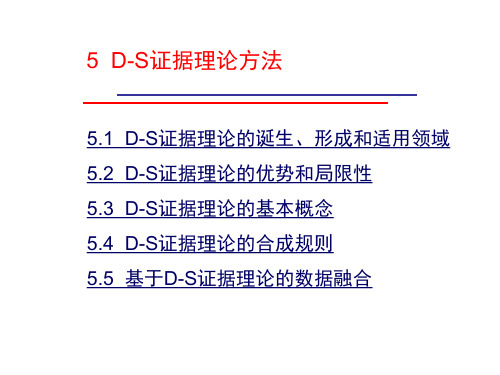
对偶(Bel(A) ,Pl(A))称为信任空间。
2021/3/7
CHENLI
7
证据区间和不确定性
信任区间
0
Bel(A)
支持证据区间
Pl(A) 拒绝证据区间
拟信区间
信任度是对假设信任程度的下限估计—悲观估计; 似然度是对假设信任程度的上限估计—乐观估计。
2021/3/7
A i 1 i n
2021/3/7
CHENLI
10
5.5 基于D-S证据理论的数据融合
传感器1 命题的证据区间
传感器2
传感器n
命题的证据区间 命题的证据区间
证
据
融
组
合
合 最终判决规则 结
规
果
则
基于D-S证据方法的信息融合框图
2021/3/7
CHENLI
11
单传感器多测量周期可信度分配的融合
A 1 A 2
A 1 A 2
2021/3/7
CHENLI
9
多个概率分配数的合成规则
多个概率分配函数的正交和 M M 1 M 2 M n定义为:
M()0, A
其中
M(A)c1
Mi(Ai), A
AiA1in
c 1 M i(A i) M i(A i)
A i 1 i n
• 适用领域:信息融合、专家系统、情报分析、法律案件分
析、多属性决策分析,等等。
2021/3/7
CHENLI
2
5.2 D-SBayes概率理论更弱的条件,即不需要知道先验 概率,具有直接表达“不确定”和“不知道”的能力。
• 局限性:
要求证据必须是独立的,而这有时不易满足;证据合 成规则没有非常坚固的理论支持,其合理性和有效性还存 在较大的争议;计算上存在着潜在的组合爆炸问题。
- 1、下载文档前请自行甄别文档内容的完整性,平台不提供额外的编辑、内容补充、找答案等附加服务。
- 2、"仅部分预览"的文档,不可在线预览部分如存在完整性等问题,可反馈申请退款(可完整预览的文档不适用该条件!)。
- 3、如文档侵犯您的权益,请联系客服反馈,我们会尽快为您处理(人工客服工作时间:9:00-18:30)。
[12] Dubois, D, Prade, H. Consonant approximations of belief functions. International Journal of Approximate Reasoning, 1990, 4: 279-283.
[13] Tessem, B. Approximations for efficient computation in the theory of evidence. Artificial Intelligence, 1993, 61:315-329. 【注:文献10-12均为证 据理论近似计算方法】 [14] Simard, M. A., et al. Data fusion of multiple sensors attribute information for target identity estimation using a Dempster-Shafer evidential combination algorithm. In: Proceedings of SPIE-International Society for Optical Engineering, 1996, Vol.2759: 577-588. 【提出了一种实现证据理论的“修 剪算法”】
适用领域:信息融合、专家系统、情报分析、法律 案件分析、多属性决策分析,等等。
4、证据理论的局限性
要求证据必须是独立的,而这有时不易满足
证据合成规则没有非常坚固的理论支持,其合理 性和有效性还存在较大的争议
计算上存在着潜在的指数爆炸问题
5、证据理论的发展概况
“Zadeh悖论”:对证据理论的合成公式的合理性进行 质疑。 例子:利用Dempster证据合成规则对两个目击证人 (W1, W2)判断某宗“谋杀案” 的三个犯罪嫌疑人(Peter, Paul, Mary)中究竟谁是真正的凶手,得到的结果(认定Paul 是凶手)却违背了人的常识推理结果,Zadeh认为这样的结果 无法接受。 m1() Peter Paul Mary 0.99 0.01 0.00 m2() 0.00 0.01 0.99 m12() 0.00 1.00 0.00
本章的主要参考文献(续3)
[15] Josang, A. The consensus operator for combining beliefs. Artificial Intelligence, 2002, 141(1-2): 157-170.
[16] Yang, Jian-Bo, Xu, Dong-Ling. On the evidential reasoning algorithm for multiple attribute decision analysis under uncertainty. IEEE Transaction on Systems, Man, and Cybernetics – Part A: Systems and Humans, 2002, 32(3): 289-304. [17] Yaghlane, B. B., et al. Belief function independence: I. The marginal case. International Journal of Approximate Reasoning, 2002, 29(1): 47-70.
本章的主要参考文献(续1)
[5] Zadeh, L. A. Review of Shafer’s a mathematical theory of evidence. AI Magazine, 1984, 5:81-83. 【对证据理论进行质疑的经典文献之一】 [6] Shafer, G. Perspectives on the theory and practice of belief functions. International Journal of Approximate Reasoning, 1990, 4: 323-362. [7] Shafer, G. Rejoinder to comments on “Perspectives on the theory and practice of belief functions”. International Journal of Approximate Reasoning, 1992, 6: 445-480. [8] Voorbraak, F. On the justification of Dempster’s rule of combination. Artificial Intelligence, 1991, 48:171-197. [9] Smets, P. The combination of evidence in the transferable model. IEEE Transactions on Pattern Analysis and Machine Intelligence, 1990, 12(5): 447-458.
March 10, 2002第一稿 September 25, 2006第四次修改稿
Outline
本章的主要参考文献 证据理论的发展简况 经典证据理论 关于证据理论的理论模型解释 证据理论的实现途径 基于DS理论的不确定性推理 计算举例
本章的主要参考文献
[1] Dempster, A. P. Upper and lower probabilities induced by a multivalued mapping. Annals of Mathematical Statistics, 1967, 38(2): 325-339. 【提出 证据理论的第一篇文献】 [2] Dempster, A. P. Generalization of Bayesian Inference. Journal of the Royal Statistical Society. Series B 30, 1968:205-247. [3] Shafer, G. A Mathematical Theory of Evidence. Princeton University Press, 1976. 【证据理论的第一本专著,标志其正式成为一门理论】 [4] Barnett, J. A. Computational methods for a mathematical theory of evidence. In: Proceedings of 7th International Joint Conference on Artificial Intelligence(IJCAI-81), Vancouver, B. C., Canada, Vol. II, 1981: 868-875. 【第一篇将证据理论引入AI领域的标志性论文】
5.1
证据理论的发展简况
证据理论(Evidential Theory) Dempster-Shafer理论 Dempster-Shafer证据理论 DS (或D-S)理论
1、证据理论的名称
其它叫法:
Dempster规则 Dempster合成规则 Dempster证据合成规则
[18] Yaghlane, B. B., et al. Belief function independence: II. The conditional case. International Journal of Approximate Reasoning, 2002, 31: 31-75.
本章的主要参考文献(续4)
3、证据理论的核心、优点及适用领域
核心:Dempster合成规则,这是Dempster在研究 统计问题时首先提出的,随后Shafer把它推广到更为一 般的情形。 优点:由于在证据理论中需要的先验数据比概率推 理理论中的更为直观、更容易获得,再加上Dempster合 成公式可以综合不同专家或数据源的知识或数据,这使 得证据理论在专家系统、信息融合等领域中得到了广泛 应用。
2、证据理论的诞生和形成
诞生:源于20世纪60年代美国哈佛大学数学家A. P. Dempster在利用上、下限概率来解决多值映射问题方面的 研究工作。自1967年起连续发表了一系列论文,标志着证 据理论的正式诞生。
形成:Dempster的学生G. Shafer对证据理论做了进一 步的发展,引入信任函数概念,形成了一套基于“证据” 和“组合”来处理不确定性推理问题的数学方法,并于 1976年出版了《证据的数学理论》(A Mathematical Theory of Evidence),这标志着证据理论正式成为一种处理不确定 性问题的完整理论。
[19] 段新生. 证据理论与决策、人工智能. 中国人民大学出版社, 1993. [20] 徐从富 等. Dempster-Shafer证据推理方法理论与应用的综述. 模 式识别与人工智能, 1999, 12(4): 424-430. [21] 徐从富 等. 面向数据融合的DS方法综述. 电子学报, 2001, 29(3): 393-396. [22] 徐从富 等. 解决证据推理中一类“0绝对化”问题的方法. 计算机 科学, 2000, 27(5): 53-56. [23] 李岳峰 等. 证据理论中的近似计算方法. 吉林大学自然科学学报, 1995, (1):28-32.
浙江大学研究生《人工智能》课件
第五章 D-S证据理论
(Chapter5 D-S Evidential Theory )
徐从富(Congfu Xu) PhD, Associate Professor
Email: xucongfu@ Institute of Artificial Intelligence, College of Computer Science, Zhejiang University, Hangzhou 31] 刘大有 等. 广义证据理论的解释. 计算机学报, 1997, 20(2): 158-164.
